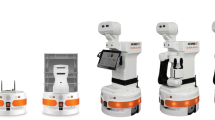Abstract
The implementation of software robots is based on the often time-consuming work carried out by the project team, which often leads to higher than expected costs and time delays. This can be made more efficient by scaling the extension of the robot’s functionalities. However, scaling can only take place once one has understood what can be scaled and to what extent. Therefore, based on an empirically illustrated theoretical conceptualization of scaling the software robot implementation, in this chapter we elaborate how scaling can be approached when implementing software robots.
Access this chapter
Tax calculation will be finalised at checkout
Purchases are for personal use only
Similar content being viewed by others
References
Adler, P. S., Goldoftas, B., & Levine, D. I. (1999). Flexibility versus efficiency? a case study of model changeovers in the Toyota production system. Organization Science, 10(1), 43–68.
Asatiani, A., & Penttinen, E. (2016). Turning robotic process automation into commercial success—Case Opuscapita. Journal of Information Technology Teaching Cases, 6(2), 67–74.
Banker, R. D., & Kauffman, R. J. (1992). Reuse and productivity in integrated computer-aided software engineering: An empirical study. MIS Quarterly, 14(3), 374–401.
Basili, V. R., Briand, L. C., & Melo, W. L. (1996). How reuse influences productivity in object-oriented systems. Communications of the ACM, 39(10), 104–116.
Benbasat, I., Goldstein, D. K., & Mead, M. (1987). The case research strategy in studies of information systems. Management Information Systems Quarterly, 11(3), 369–386.
Bostrom, N. 2014. Superintelligence: Paths, Dangers, Strategies. OUP Oxford.
Chandler, A. D. (1990). Strategy and structure: Chapters in the history of the industrial enterprise. MIT press.
D’Adderio, L. (2011). Artifacts at the centre of routines: Performing the material turn in routines theory. Journal of Institutional Economics, 7(2), 197–230.
Dolgui, A., & Proth, J.-M. (2013). Outsourcing: Definitions and analysis. International Journal of Production Research, 51(23–24), 6769–6777.
Eisenhardt, K. (1989). Building theories from case study research. Academy of Management Review, 14(4), 532–550.
Feldman, M. S., Pentland, B. T., D’Adderio, L., & Lazaric, N. (2016). Beyond routines as things: Introduction to the special issue on routine dynamics. Organization Science, 27(3), 505–513.
Fung, H. P. (2014). Criteria, use cases and effects of information technology process automation (Itpa),” Advances in Robotics & Automation (3).
Guzman, I., & Pathania, A. (2016). Chatbots in customer service. Retrieved October 25, 2017, from https://www.accenture.com/t00010101T000000__w__/br-pt/_acnmedia/PDF45/Accenture-Chatbots-Customer-Service.pdf.
Heller, B., Proctor, M., Mah, D., Jewell, L., & Cheung, B. (2005). “Freudbot: An investigation of Chatbot technology in distance education. In EdMedia: World Conference on Educational Media and Technology: Association for the Advancement of Computing in Education (AACE), pp. 3913–3918.
Henfridsson, O., & Bygstad, B. (2013). The generative mechanisms of digital infrastructure evolution. MIS Quarterly 907–931.
Hildebrand, M., Eliëns, A., Huang, Z., & Visser, C. (2003). Interactive agents learning their environment. In International Workshop on Intelligent Virtual Agents (pp. 13–17). Berlin: Springer
Huang, J., Henfridsson, O., Liu, M. J., & Newell, S. (2017). Growing on steroids: Rapidly scaling the user base of digital ventures through digital innovation. MIS Quarterly, 41(1).
Leonardi, P. M. (2011). When flexible routines meet flexible technologies: Affordance, constraint, and the imbrication of human and material agencies. MIS Quarterly, 35(1), 147–167.
Miles, M., & Huberman, A. (1994). Qualitative data analysis: An expanded sourcebook. London: Sage Publications.
Oshri, I., Kotlarsky, J., & Willcocks, L. P. (2015). The handbook of global outsourcing and offshoring, 3rd Edn. Springer.
Patil, A., Marimuthu, K., & Niranchana, R. (2017). Comparative study of cloud platforms to develop a Chatbot. International Journal of Engineering & Technology, 6(3), 57–61.
Pfeifer, R., Lungarella, M., & Iida, F. (2007). Self-organization, embodiment, and biologically inspired robotics. Science, 318(5853), 1088–1093.
Sahay, S., & Walsham, G. (2006). Scaling of health information systems in India: Challenges and approaches. Information Technology for development, 12(3), 185–200.
Schwab, K. (2017). The fourth industrial revolution. Crown Business.
Sengupta, R., & Lakshman, S. (2017). Conversational Chatbots—Let’s Chat. Retrieved October 25, 2017, from https://www2.deloitte.com/content/dam/Deloitte/in/Documents/strategy/instrategy-innovation-conversational-chatbots-lets-chat-final-report-noexp.pdf.
Sharma, P., Southern, R., & Dalton, D. (2016). The discruptive Chat Bots—Sizing up real opportunities for business. Retrieved 25 Oct, 2017, from https://www2.deloitte.com/content/dam/Deloitte/ie/Documents/ie-dispruptivechat-bots.pdf.
Shawar, B. A., & Atwell, E. (2007). Different measurements metrics to evaluate a Chatbot Syste. In Proceedings of the Workshop on Bridging the Gap: Academic and Industrial Research in Dialog Technologies (pp. 89–96). Rochester, NY, USA: Association for Computational Linguistics.
Slaby, J. R. (2012). Robotic automation emerges as a threat to traditional low-cost outsourcing, HfS Research Ltd.
Star, S. L., & Ruhleder, K. (1996). Steps toward an ecology of infrastructure: Design and access for large information spaces. Information Systems Research, 7(1), 111–134.
Sutherland, C. (2013). Framing a constitution for robotistan. Hfs Research.
Svahn, F., Mathiassen, L., & Lindgren, R. (2017). Embracing digital innovation in incumbent firms: How Volvo cars managed competing concerns. MIS Quarterly (41:1).
Tirgul, C. S., & Naik, M. R. (2016). Artificial intelligence and robotics. International Journal of Advanced Research in Computer Engineering & Technology, 5(6), 1787–1793.
Willcocks, L., & Lacity, M. C. (2016). Service automation: Robots and the future of work. Steve Brookes Publishing.
Yin, R. (2003). Case study research. California: Thousand Oaks.
Yoo, Y., Boland, R. J., Jr., Lyytinen, K., & Majchrzak, A. (2012). Organizing for innovation in the digitized world. Organization Science, 23(5), 1398–1408.
Author information
Authors and Affiliations
Corresponding author
Editor information
Editors and Affiliations
Copyright information
© 2020 Springer Nature Switzerland AG
About this chapter
Cite this chapter
Rutschi, C., Dibbern, J. (2020). Towards an Understanding of Scaling the Software Robot Implementation. In: Hirschheim, R., Heinzl, A., Dibbern, J. (eds) Information Systems Outsourcing. Progress in IS. Springer, Cham. https://doi.org/10.1007/978-3-030-45819-5_18
Download citation
DOI: https://doi.org/10.1007/978-3-030-45819-5_18
Published:
Publisher Name: Springer, Cham
Print ISBN: 978-3-030-45818-8
Online ISBN: 978-3-030-45819-5
eBook Packages: Business and ManagementBusiness and Management (R0)




